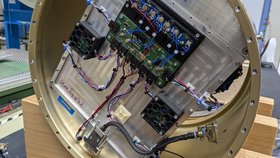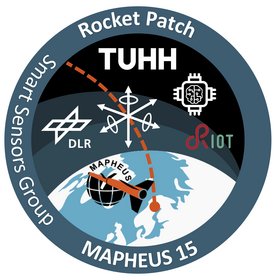MAPHEUS 15 – 600th rocket launch beyond the Arctic Circle
TU Hamburg on board with experiments on smart sensors
12.11.2024

On 11 November 2024 at 07:38 UTC, a research rocket soared over the icy expanse of Swedish Lapland for the 600th time. The mission, MAPHEUS 15 (Material Physics Experiments under Zero Gravity), carried 21 scientific experiments from both the German Aerospace Center (Deutsches Zentrum für Luft- und Raumfahrt; DLR) and international collaborators.
During its flight above the Arctic Circle, MAPHEUS 15 reached a record-breaking altitude of 309 km, providing seven minutes of microgravity for its experiments – an increase over the previous six minutes. While this additional minute may not seem like much, it is significant for science research; terrestrial microgravity experiments, like those conducted in drop towers or on parabolic flights, typically offer just a few seconds of 'weightlessness'.
This higher altitude was made possible by a new rocket motor configuration, which combines the tried-and-tested 'Improved Malemute' – originally a military upper stage repurposed for scientific use – with the RED KITE motor as a booster. RED KITE is a joint innovation from Bayern-Chemie and DLR.
TU Hamburg tests sensor systems
This time, Hamburg University of Technology is involved in the flight into weightlessness. As part of the Smart Sensors Group, Prof Ulf Kulau and his team are testing the requirements for miniaturised sensor systems for space applications: "The upcoming manned space missions beyond low-Earth orbit mean that solutions for robust, autonomous and reliable health monitoring of astronauts need to be developed," explains Kulau. The Smart Sensors Group coordinates the DLR-funded AuRelia and SArES projects and, together with other project partners, is researching radiation-tolerant sensor systems for cardio-vascular monitoring using seismocardiography (SCG). This method is based on very low-noise and sensitive measuring units (IMUs) that can measure the movements caused by the heart on the surface of the body. In order to be able to test the developed sensor system under space and extreme environmental conditions, it will fly as a payload on the MAPHEUS 15 sounding rocket under the project name Rocket Patch. At an altitude of over 300 kilometres, the sensors will be above the Kármán line of 100 kilometres for a short time and will therefore be exposed to the real temperature and pressure conditions of space.

Christopher Büchse, PhD student at the Smart Sensors Group, was largely responsible for the implementation of Rocket Patch and installed a total of six of these sensor systems together with a specially developed synchronisation unit in a DLR module. "The data from the flight in zero gravity is extremely valuable for all of the Smart Sensors Group's measurements in order to derive new methods for calibrating the sensors with regard to artefact formation during SCG measurements", says Prof. Kulau. Artefacts on the acceleration values can occur due to changes in the position of the sensors in relation to the acceleration due to gravity. This effect can be investigated in more detail due to the strong acceleration changes up to weightlessness during the flight on MAPHEUS 15.
More experiments than ever before
The latest MAPHEUS mission features a record number of experiments onboard. "We have many smaller experiments, with their design inspired by CubeSats and each side of the cube measuring ten centimetres," explains Thomas Voigtmann, MAPHEUS project manager at the DLR Institute of Materials Physics in Space. "To accommodate all these small experiments, we have developed two specialised rocket segments called MOSAIC, which can house these compact set-ups. This arrangement reduces development time and costs for each experiment, allowing a greater number to fly onboard."
Voigtmann adds, "Other MAPHEUS highlights include new collaborations with Australian institutions, including the University of Adelaide and La Trobe University in Melbourne, plus Enable Aerospace, a company which has developed its own experimental hardware. We are also testing a smartwatch developed in collaboration with Samsung, adesso and LambSpace – a NewSpace company from North Rhine-Westphalia – which is set to be spaceflight tested for use in life support systems and the cryptographically secure collecting of health data."
In addition to experiments from DLR’s Institute of Materials Physics in Space (MP) and various international partners, the DLR Institutes of Materials Research (WF), Aerospace Medicine (ME) and Solar-Terrestrial Physics (SO), as well as theSpace Operations and Astronaut Training institution, are participating in the mission’s test campaign.
About the project
MAPHEUS, short for 'Material Physics Experiments under Zero Gravity', is a high-altitude research programme initiated by the German Aerospace Center (DLR). Since 2009, the programme has conducted regular flights using sounding rockets. Scientifically, it is managed by the DLR Institute of Materials Physics in Space and the DLR Institute of Aerospace Medicine. The Mobile Rocket Base (MORABA), part of DLR's Space Operations and Astronaut Training institute, oversees the research flights launched from the Esrange site, operated by the Swedish Space Corporation (SSC).
More Information:
https://www3.tuhh.de/e-exk3/Research/AuRelia/ and https://www3.tuhh.de/e-exk3/Research/SArES/
https://event.dlr.de/ila2024/spacepatch/
TUHH - Public Relations Office
Elke Schulze
E-Mail: elke.schulze@tuhh.de







